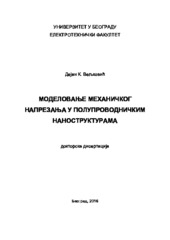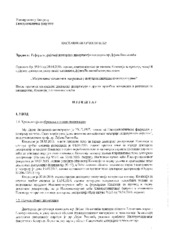Приказ основних података о дисертацији
Mоделовање механичког напрезања у полупроводничким наноструктурама
Mecahnical stress modelling in semiconductor nanostructures
| dc.contributor.advisor | Raković, Dejan | |
| dc.contributor.other | Tadić, Milan | |
| dc.contributor.other | Romčević, Nebojša | |
| dc.contributor.other | Popović-Božović, Jelena | |
| dc.contributor.other | Đurišić, Željko | |
| dc.creator | Veljković, Dejan K. | |
| dc.date.accessioned | 2016-09-18T07:48:31Z | |
| dc.date.available | 2016-09-18T07:48:31Z | |
| dc.date.available | 2020-07-03T08:36:21Z | |
| dc.date.issued | 2016-08-30 | |
| dc.identifier.uri | http://eteze.bg.ac.rs/application/showtheses?thesesId=3876 | |
| dc.identifier.uri | https://nardus.mpn.gov.rs/handle/123456789/6576 | |
| dc.identifier.uri | https://fedorabg.bg.ac.rs/fedora/get/o:13022/bdef:Content/download | |
| dc.identifier.uri | https://fedorabg.bg.ac.rs/fedora/get/o:13132/bdef:Izvestaj/download | |
| dc.identifier.uri | http://vbs.rs/scripts/cobiss?command=DISPLAY&base=70036&RID=48207119 | |
| dc.description.abstract | Током последњих двадесет година много пута је показано да је технолошки могуће добити наноструктуре у облику вертикално и периодично поређаних квантних тачака - КТ стекова. Овакве наноструктуре могу наћи потенцијалну примену у полупроводничкој ласерској технологији, или за израду соларних ћелија. До данас није објављен ниједан научни рад у коме су изведени аналитички изрази за израчунавање механичких деформација унутар КТ стекова. Известан број радова бавио се израчунавањем механичких деформација применом нумеричких метода, и то за КТ стекове састављене од мањег броја квантних тачака. У овој докторској дисертацији анализирани су вертикални стекови полупроводничких квантних тачака без дислокација, уграђених у супстрат полупроводника друге врсте, за епитаксијални раст у кристалном правцу (001). Изведени су аналитички изрази за деформацију унутар оба полупроводника у случају када су дебљине квантних тачака и супстратских одстојника довољно мале у односу на попречне димензије стека. У конкретним случајевима, када се стек састоји од InxGa1-xAs квантних тачака унутар GaAs супстрата, где x узима вредности 0,25; 0,5; 0,75 и 1,0, израчунати резултати приказани су графички. Ови резултати показали су да контролом односа броја монослојева у квантној тачки и броја монослојева у периоду стека (односа ξ) деформација унутар квантне тачке може бити прецизно контролисана. На тај начин могуће је прецизно контролисати и електронскa и оптичкa својства квантних тачака које зависе од деформације, што је и показано у случају свих испитаних наноструктура. Од електронских својстава наноструктуре израчунате су и графички представљене промене растојања дна проводне зоне од врха зона лаких и тешких шупљина у случају свих испитаних наноструктура. Мања од тих двеју промена одређује и промену ефективног енергетског процепа. Промена растојања дна проводне зоне од врха зоне тешких шупљина се благо мења са односом ξ, док се растојање од врха зоне лаких шупљина мења са много већим нагибом, и ова чињеница отвара могућности за контролу енергетског процепа мењањем односа ξ. Промену енергетског процепа са променом односа ξ диктира растојања дна проводне зоне од врха зона лаких шупљина, почевши од вредности односа ξ = 0,592, тј у интервалу 0,592 ≤ ξ ≤ 1, и ово је управо интервал од интереса, у поменутом смислу, и то за све испитане наноструктуре. | sr |
| dc.description.abstract | It was proven many times during the past twenty years that the vertical alignment of the semiconductor quantum dots into the vertical stacks - QD stacks, is technologically possible. This kind of nanostructures could be appropriate for the applications in the semiconductor laser technology, and for the solar cells fabrication. Until now, there is no published scientific paper about the analytical strain evaluation inside QD stacks. Some of the published papers have discussed results obtained by the numerical methods for the stacks which have consisted of several quantum dots. In this Doctoral Dissertation the vertical stacks of semiconductor quantum dots without dislocations, incorporated in the other semiconductor substrate, for the epitaxial growth in the crystal direction (001) were considered. Analytical expressions for the strain in the both semiconductors were derived for the case when the thicknesses of quantum dots and the substrate spacers are small enough in comparision with the stack lateral dimensions. In the particular cases when the stack consists of InxGa1-xAs quantum dots in the GaAs substrate, where x takes values 0.25; 0.5; 0.75 and 1.0, the obtained results were calculated and shown graphically. These results have shown that by controlling ratio between the number of monolayers in InAs quantum dots and number of monolayers in the stack period (ratio ξ), quantum dots strain could be precisely controlled. In this way, the electronic and optical properties of quantum dots, which depend on the strain, could be controlled precisely, and that was shown for all of the tested nanostructures. Among the nanostructure electronic properties, the changes in distances between the bottom of the conduction zone, and the tops of the heavy hole and light hole zones, for all of the tested nanostructures, were calculated and graphically presented. From these two changes, smaller one determines the change in the effective energy gap.Distance change from the bottom of conduction zone to the top of heavy hole zone slightly varies with the ratio ξ, while the distance change from the bottom of conduction zone to the top of light hole zone varies with a pretty greater slope, and this fact opens the new possibilities for the energy gap control by changing ratio ξ. Changing of energy gap with changing ratio ξ is dictated by the distance from the bottom of conduction zone to the top of light hole zone, starting with the ratio ξ = 0.592, i.e. in the interval 0.592 ≤ ξ ≤ 1, and this is the interval of interest, as interpreted above, for all of the tested nanostructures. | en |
| dc.format | application/pdf | |
| dc.language | sr | |
| dc.publisher | Универзитет у Београду, Електротехнички факултет | sr |
| dc.rights | openAccess | en |
| dc.rights.uri | https://creativecommons.org/licenses/by-nc-nd/4.0/ | |
| dc.source | Универзитет у Београду | sr |
| dc.subject | деформација | sr |
| dc.subject | strain | en |
| dc.subject | mechanical stress | en |
| dc.subject | nanostructures | en |
| dc.subject | analytical evaluation | en |
| dc.subject | quantum dots | en |
| dc.subject | stacks | en |
| dc.subject | monolayers | en |
| dc.subject | semiconductors | en |
| dc.subject | electronic properties | en |
| dc.subject | energy gap | en |
| dc.subject | механички напон | sr |
| dc.subject | наноструктуре | sr |
| dc.subject | аналитичко извођење | sr |
| dc.subject | квантне тачке | sr |
| dc.subject | стекови | sr |
| dc.subject | монослојеви | sr |
| dc.subject | полупроводници | sr |
| dc.subject | електронска својства | sr |
| dc.subject | енергетски процеп | sr |
| dc.title | Mоделовање механичког напрезања у полупроводничким наноструктурама | sr |
| dc.title | Mecahnical stress modelling in semiconductor nanostructures | en |
| dc.type | doctoralThesis | en |
| dc.rights.license | BY-NC-ND | |
| dcterms.abstract | Раковић, Дејан; Ромчевић, Небојша; Тадић, Милан; Поповић-Божовић, Јелена; Ђуришић, Жељко; Вељковић, Дејан К.; Modelovanje mehaničkog naprezanja u poluprovodničkim nanostrukturama; | |
| dc.identifier.fulltext | https://nardus.mpn.gov.rs/bitstream/id/5904/Disertacija4590.pdf | |
| dc.identifier.fulltext | https://nardus.mpn.gov.rs/bitstream/id/5905/IzvestajKomisije4590.pdf | |
| dc.identifier.fulltext | http://nardus.mpn.gov.rs/bitstream/id/5904/Disertacija4590.pdf | |
| dc.identifier.fulltext | http://nardus.mpn.gov.rs/bitstream/id/5905/IzvestajKomisije4590.pdf | |
| dc.identifier.rcub | https://hdl.handle.net/21.15107/rcub_nardus_6576 |



